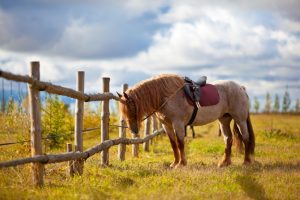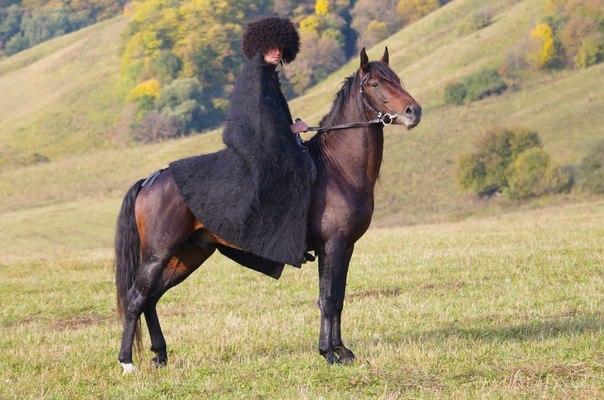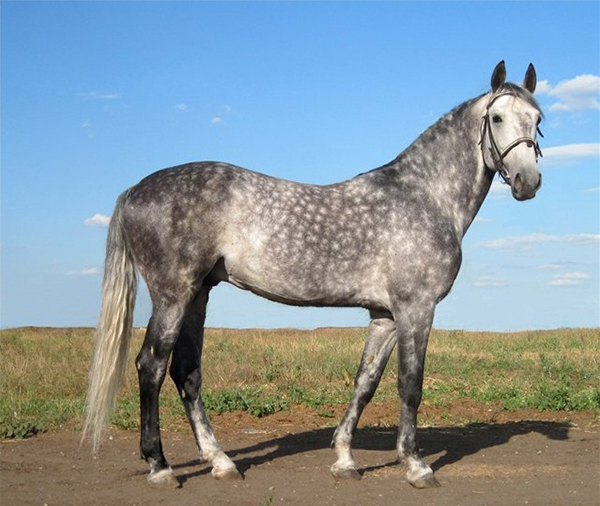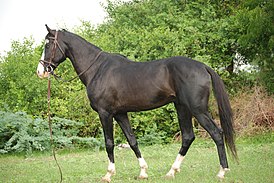Pride of Russian horse breeding – Vladimir heavy truck
 Strong horses were needed in the Middle Ages in order to bear the knight in full armor. Their weight could reach a ton, and height – 2 m. With this build, war knightly horses quickly tired and could not jump. Over time, the ancestors of the Vladimir breed, the English Shires, also came from them.
Strong horses were needed in the Middle Ages in order to bear the knight in full armor. Their weight could reach a ton, and height – 2 m. With this build, war knightly horses quickly tired and could not jump. Over time, the ancestors of the Vladimir breed, the English Shires, also came from them.
The heavy-duty breed Vladimir heavy truck was created not so long ago. Excretion took place in the Vladimir Opole, where the soil is mainly heavy and difficult to open. For the processing of fields there was a need for strong horses. In addition, horse-drawn transport was needed due to urban growth. All these were prerequisites for the emergence of heavy trucks in the Vladimir region.
A strong workhorse has always been needed in our country. A particularly urgent need arose at the end of the 19th century, when heavy iron plows replaced the wooden plow and harrow. An ordinary peasant horse could not cope with them. Especially in the loams of the present Ivanovo and Vladimir regions. The horse breed Vladimir heavy truck The breed itself was bred by crossing local horses with English shires and Scottish kledesdelami. Individuals of these breeds were purchased in England in the 20s. The most important role in obtaining the new breed was played by three kledesdesal stallions. Shires were predominantly females. In addition, horses of the Suffolk breed played an insignificant role in the selection. Local mares gave the breed endurance in work and adaptability to the conditions of the region.
Crossing and breeding took place in the Gavrilo-Posad breeding nursery and the stable of the same name. In 1946, the new Vladimir horse was officially registered as a heavy truck. Breed improvement was carried out at the Ivanovo Agricultural Institute. Selection and selective selection of individuals was done according to their working capacity, physique, dryness, and growth of horses. Horse breed Vladimir heavy truck
Description
Horse Vladimir heavy truck is difficult to confuse with another. Only partially did it retain similarity with its ancestors (kledesdaly and shire). The animals have a long round head, with a convex profile, sitting on a muscular neck. Withers high, chest wide. The back of heavy trucks is a bit soft, the croup is forked and wide, slightly drooping.
The breed has dry, long limbs. Some individuals have friezes (overgrown legs). They are prone to biting midges. Brushes often form in the area of the put joints. The tail and mane are thick and long. The suit is usually bay, sometimes there are animals with a black color, or red (with white spots on the head and legs). The head of a horse of the breed Vladimir heavy truck It is important to know that Vladimir horses never have white spots on their stomachs. The growth is slightly higher than the growth of glue makers, second only to the Soviet heavy truck and shire. In terms of strength, the breed is slightly behind the last two, but it shows the best results in the formula “mass – speed – endurance”. By weight and dimensions, the Vladimir residents are considered the largest of the Russian heavy-duty breeds.
The average indices of stallions: height at the withers of 165 cm, oblique body length of 173 cm, metacarpus circumference of 24 cm, chest – 207 cm. For mares by the same parameters: 162, 169, 23 and 198, respectively. The body weight of males is up to 760 kg, females – up to 690 kg.
The main advantage of the “Vladimir” is their incredible performance. Frisky, strong, they can trot with a cart of 1.5 tons two kilometers in 5 minutes. With a load of 4.5 tons and a step, the same distance will pass in 15 minutes. The breed has a peculiar step – wide, with a large grip and good extension. Without load, horses can trot to run a distance of 1600 m in 3 minutes. It is significant that it was on horses of the Vladimir breed that the transition from Moscow to Vladivostok was recently completed. Vladimir horse at a performance
Temper
Both mares and stallions of the Vladimir breed are calm. Animals quickly get used to the owner and the team yields well. True, there are some individuals “with character.”
The breed is quite energetic, so young animals may not first obey the owner. However, with gentle treatment and a good approach, horses quickly become disciplined.
In general, animals are easy to manage, and playfulness allows them to be used in the famous Russian triples.
To the local conditions Vladimir heavy trucks quickly adapt. The horses can work both in the heat and under the snow. The move in animals is especially good in lynx – at exhibitions, heavyweights demonstrate unusual refinement and grace for their mass. Horses love to go galloping, and their step is appreciated by any breed, especially large ones. The Vladimir heavy truck in the Vladimiritsa stables grow up early – at the age of three, the animals are ready for reproduction and work. Males are famous for their fertility. Mares usually bring one foal. With normal feeding and maintenance, the yield of offspring is 80%. It has been observed that females have high milkiness, since initially there was a need for a large baby in a large amount of milk.




